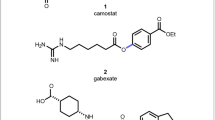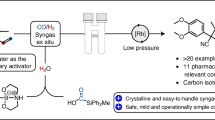Abstract
This protocol provides a rapid method for evaluating the tolerance of a given set of reaction conditions to a wide range of functional groups, as well as the stability of functional groups to the reaction conditions. This information is highly desirable when considering the application of a given protocol in the preparation of complex compounds, including natural products or biologically active molecules. By using a contemporary Rh(III)-catalyzed C-H activation protocol for the preparation of indole derivatives as a demonstrative example, here we describe a simple process that uses batch reaction preparation, small-scale parallel reaction techniques, simplified gas chromatography (GC) calibration techniques and GC analysis to undertake this evaluation in a rapid and cost-effective manner. This analysis provides quantitative data for a large number of functional groups and heterocycles, and it is readily adaptable to investigate structural motifs of choice, such as common moieties or functional groups within a given medicinal or agrochemical project or within a family of natural products. Twenty chosen additives plus controls can be evaluated in ∼3 d depending on the reaction time, with actual reaction setup and analysis taking 12–24 h depending on the reaction.
This is a preview of subscription content, access via your institution
Access options
Subscribe to this journal
Receive 12 print issues and online access
$259.00 per year
only $21.58 per issue
Buy this article
- Purchase on Springer Link
- Instant access to full article PDF
Prices may be subject to local taxes which are calculated during checkout


Similar content being viewed by others
References
Wender, P.A. & Miller, B.L. Synthesis at the molecular frontier. Nature 460, 197–201 (2009).
Nadin, A., Hattotuwagama, C. & Churcher, I. Lead-oriented synthesis: a new opportunity for synthetic chemistry. Angew. Chem. Int. Ed. 51, 1114–1122 (2012).
Nicolaou, K.C., Vourloumis, D., Winssinger, N. & Baran, P.S. The art and science of total synthesis at the dawn of the twenty-first century. Angew. Chem. Int. Ed. 39, 44–122 (2000).
Müller, T.J.J. & Bunz, U.H.F. Functional Organic Materials: Syntheses, Strategies and Applications (Wiley, 2007).
Li, J.J. & Johnson, D.S. Modern Drug Synthesis (Wiley, 2010).
Lamberth, C. & Dinges, J. Bioactive Heterocyclic Compound Classes: Pharmaceuticals and Agrochemicals (Wiley, 2012).
Collins, K.D. & Glorius, F. A robustness screen for the rapid assessment of chemical reactions. Nat. Chem. 5, 597–601 (2013).
Collins, K.D. & Glorius, F. Employing a robustness screen: rapid assessment of rhodium(III)-catalysed C–H activation reactions. Tetrahedron 69, 7817–7825 (2013).
Churcher, I. Reaction methodology: speed dating for reactions. Nat. Chem. 5, 554–555 (2013).
Muci, A.R. & Buchwald, S.L. Practical palladium catalysts for C-N and C-O bond formation. Top. Curr. Chem. 219, 133–209 (2002).
Hartwig, J. Approaches to catalyst discovery. New carbon-heteroatom and carbon-carbon bond formation. J. Pure Appl. Chem. 71, 1417–1423 (1999).
Guram, A.S., Rennels, R.A. & Buchwald, S.L. A simple catalytic method for the conversion of aryl bromides to arylamines. Angew. Chem. Int. Ed. Engl. 34, 1348–1350 (1995).
Louie, J. & Hartwig, J.F. Palladium-catalyzed synthesis of arylamines from aryl halides mechanistic studies lead to coupling in the absence of tin reagents. Tetrahedron Lett. 36, 3609–3612 (1995).
Kuhl, N., Schröder, N. & Glorius, F. Rh(III)-catalyzed halogenation of vinylic C–H bonds: rapid and general access to Z-halo acrylamides. Org. Lett. 15, 3860–3863 (2013).
Wang, H., Beiring, B., Yu, D.-G., Collins, K.D. & Glorius, F. [3]Dendralene synthesis: Rhodium(III)-catalyzed alkenyl CH activation and coupling reaction with allenyl carbinol carbonate. Angew. Chem. Int. Ed. 52, 12430–12434 (2013).
Tang, D.-T.D., Collins, K.D., Ernst, J.B. & Glorius, F. Pd/C as a heterogeneous catalyst for completely regioselective and mild C–H functionalisation of thiophenes. Angew. Chem. Int. Ed. 53, 1809–1813 (2014).
Lee, H.G., Milner, P.J. & Buchwald, S.L. An improved catalyst system for the Pd-catalyzed fluorination of (hetero)aryl triflates. Org. Lett. 15, 5602–5605 (2013).
Cullen, S.C., Shekhar, S. & Nere, N.K. Cu-catalyzed couplings of aryl iodonium salts with sodium trifluoromethanesulfinate. J. Org. Chem. 78, 12194–12201 (2013).
Zhao, D., Shi, Z. & Glorius, F. Indole synthesis by rhodium(III)-catalyzed hydrazine-directed C-H activation: redox-neutral and traceless by N-N bond cleavage. Angew. Chem. Int. Ed. 52, 12426–12429 (2013).
Collins, K.D., Rühling, A., Lied, F. & Glorius, F. Rapid assessment of protecting group stability using a robustness screen. Chem. Eur. J. 20, 3800–3805 (2014).
Stephan, D.W. et al. Metal-free catalytic hydrogenation of polar substrates by frustrated Lewis pairs. Inorg. Chem. 50, 12338–12348 (2011).
Tsui, G.C., Dougan, P. & Lautens, M. Metal–ligand binding affinity vs. reactivity: qualitative studies in Rh(I)-catalyzed asymmetric ring-opening reactions. Org. Lett. 15, 2652–2655 (2013).
Bissember, A.C., Levina, A. & Fu, G.C. A mild, palladium-catalyzed method for the dehydrohalogenation of alkyl bromides: synthetic and mechanistic studies. J. Am. Chem. Soc. 134, 14232–14237 (2012).
DeAngelis, A., Taylor, M.T. & Fox, J.M. Unusually reactive and selective carbonyl ylides for three-component cycloaddition reactions. J. Am. Chem. Soc. 131, 1101–1105 (2009).
Ziegler, D.T. et al. A versatile approach to Ullmann C–N couplings at room temperature: new families of nucleophiles and electrophiles for photoinduced, copper-catalyzed processes. J. Am. Chem. Soc. 135, 13107–13112 (2013).
Schröder, N., Wencel-Delord, J. & Glorius, F. High yielding, versatile and practical [Rh(III)Cp*]-catalyzed ortho-bromination and iodination of arenes. J. Am. Chem. Soc. 134, 8298–8301 (2012).
Shi, Z., Koester, D.C., Boultadakis-Arapinis, M. & Glorius, F. Rh(III)-catalyzed synthesis of multisubstituted isoquinoline and pyridine N-oxides from oximes and diazo compounds. J. Am. Chem. Soc. 135, 12204–12207 (2013).
Stuart, D.R., Villemure, E. & Fagnou, K. Elements of regiocontrol in palladium-catalyzed oxidative arene cross-coupling. J. Am. Chem. Soc. 129, 12072–12073 (2007).
Taylor, J.E., Jones, M.D., Williams, J.M.J. & Bull, S.D. Friedel-Crafts acylation of pyrroles and indoles using 1,5-diazabicyclo[4.3.0]non-5-ene (DBN) as a nucliophilic catalyst. Org. Lett. 12, 5740–5743 (2010).
Acknowledgements
Generous financial support by the Deutsche Forschungsgemeinschaft (DFG) (SFB 858 and Leibniz award) and the Alfried Krupp von Bohlen und Halbach Foundation is gratefully acknowledged. We thank D.-B. Zhao for helpful discussions and K. Gottschalk for support in compiling the manuscript.
Author information
Authors and Affiliations
Contributions
K.D.C. and F.G. designed the concept and the protocol. A.R. performed all experimental work. All authors co-wrote the paper.
Corresponding author
Ethics declarations
Competing interests
The authors declare no competing financial interests.
Supplementary information
Supplementary Methods
Images of non-commercial equipment. (PDF 12206 kb)
Supplementary Data 1
Example of reporting the Robustness screen. (PDF 584 kb)
Supplementary Data 2
Robustness screen template for calculations (includes and original data set). (XLSX 22 kb)
Rights and permissions
About this article
Cite this article
Collins, K., Rühling, A. & Glorius, F. Application of a robustness screen for the evaluation of synthetic organic methodology. Nat Protoc 9, 1348–1353 (2014). https://doi.org/10.1038/nprot.2014.076
Published:
Issue Date:
DOI: https://doi.org/10.1038/nprot.2014.076
This article is cited by
-
Superelectrophilic aluminium(iii)–ion pairs promote a distinct reaction path for carbonyl–olefin ring-closing metathesis
Nature Catalysis (2020)
-
Bio-additive-based screening: toward evaluation of the biocompatibility of chemical reactions
Nature Protocols (2019)
-
Catalytic C–H bond silylation of aromatic heterocycles
Nature Protocols (2015)
-
Contemporary screening approaches to reaction discovery and development
Nature Chemistry (2014)
Comments
By submitting a comment you agree to abide by our Terms and Community Guidelines. If you find something abusive or that does not comply with our terms or guidelines please flag it as inappropriate.



